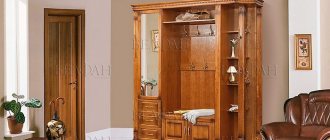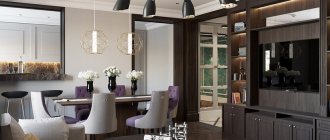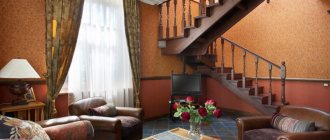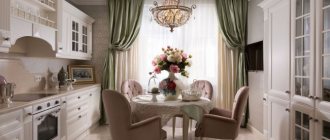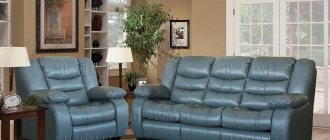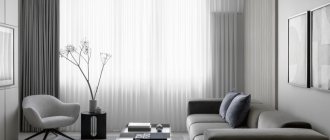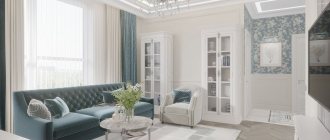Photo: furnilux.ru Since its inception, classicism has become the most luxurious and rich style. Despite the popularity of minimalist trends, it is still not losing ground. Classic living rooms are spacious, with eye-catching furniture and elegant decor, with extremely high ceilings or even a fireplace. If this is exactly what you have been dreaming of for a long time, we are ready to share our secrets and tell you how to bring such an interior to life!
Features of the classic style
The classical style is interesting for its combination of the incongruous: it is at the same time diverse, but with strict canons. The interiors may differ beyond recognition, but they will still have common features. Classic interiors are built around a distinct center: a sofa, a dining table, a fireplace, a massive chandelier. This is necessarily an open space, clear geometry, strictly consistent composition, simple forms with lush decoration. Don’t forget that classics developed differently in different regions, and everywhere had their own fashion trends and regional characteristics.
Classicism as such goes back to ancient traditions. He borrowed a lot from the design of luxurious ancient Greek and Roman houses and temples. These are light colors, marble, natural materials, massive columns, stucco - all this came to life again by the 18th century.
At approximately the same time, from the 17th century until the 19th century, different European countries arose and strengthened their own historical styles. Lush and overloaded Baroque successfully coexisted with the complex abstract Empire style or the monumental and laconic English style. Local ethnic characteristics were evident everywhere: for example, the French Baroque was significantly different from the Russian.
Modern classics are a great option for the living room
Neoclassicism, which was formed at the turn of the 18th-19th centuries, remains a popular trend today, because it adapts and transforms to changing requirements, allowing you to organize space elegantly, but at the same time comfortably - according to the most current requirements and trends. The living room and modern classics as the fundamental style can be technological and functional, especially when built-in structures and the latest ideas from designers contribute to this.
An elegant, discreet living room interior in a neoclassical style is a compromise that allows you to create a simple and harmonious space in a natural palette. Among the recognizable features:
- Symmetry, characteristic and preserved from traditional classics. This is achieved by using paired parts. These are vases, armchairs, columns, floor lamps and other design elements.
- Simple and smooth lines, elegant furniture designs, but light, not massive.
- Lots of free, bright space.
- The presence of arches and perhaps even enfilades.
- A combination of natural materials with modern practical coatings.
- A living room in a modern style will be calm and restrained, moderately decorated, but not conservative.
From the previously formed classicism in such an environment, draperies, textile wallpaper, and ceremonial portals may be present. But their decoration will be less voluminous and pompous. More minimalistic solutions are especially relevant in an apartment where a modern classic interior cannot be too monumental and embossed.
Color spectrum
The classic living room is decorated in a consistent and natural color scheme, but complex shades are used. In the foreground are light milky, cream and pastel colors or all shades of wood. As accents - deep and noble wine, emerald, sapphire, terracotta, grape.
White living room in classic style
If you have a relatively small space that you want to enlarge, or you like more restrained interiors, use white as a base. But keep in mind that classic is not a sterile snow-white laboratory or cold steel high-tech. Use milky or cream shades, combine white with wood, use complex textured materials.
Brown living room in a classic style
Brown is perhaps the most classic color in the interior, and certainly one of the most diverse. You have at your disposal any shades of natural wood: from the lightest to almost black or reddish. Use wooden furniture, cover the walls with brown panels, lay parquet flooring, use tapestries, bedspreads and other accessories.
Red living room in classic style
One of the most daring and extravagant solutions is the red living room. The classic style is an excellent opportunity to make it noble and not too aggressive: the main thing is to choose the right shade. You don't need fire scarlet, but ruby, garnet, burgundy, cherry, marsala and any other complex variations are an excellent choice for luxurious classicism.
Blue living room in classic style
If you have a large and bright room with south-facing windows, you can refresh it and make it airier with shades of blue. For the classics, you have two options: pastel cornflower blue tones or deep and rich azure, ultramarine, sapphire and dark shades of the night sky. Deep turquoise and sea green look interesting - they also naturally fit into classic interiors.
Green living room in a classic style
If you want to always feel fresh and be able to relax or unwind, choose calm green shades. But instead of herbaceous and light green, pay attention to dark emerald, malachite, marsh shades, pistachio, olive and mint. Such a wide range of possibilities allows you to design the interior in both light and dark colors - to suit your taste.
Surface finishing: ceiling, floor, walls
Neoclassicism is democratic, of course. But up to certain limits. In the field of finishing it cannot be called such. Natural materials still dominate here. If you use “substitutes” or analogues, then choose the most expensive and high-quality ones. To make the finish both classic and innovative, adhere to the following points:
- symmetrical placement of interior objects;
- correctness in proportions, lines (adhere to the “golden ratio”);
- minimum furniture;
- different types of lighting.
The new classic loves color sophistication, so if you plan to use sand, beige, brown, olive shades, you should mix a little gold and silver into them.
The new classic loves color sophistication, so if you plan to use sand, beige, brown, olive shades, you should mix a little gold and silver into them
Vertical surfaces in the hall, that is, walls, are usually finished with wallpaper, decorative or Venetian plaster, wood panels, and paint. In the latter case, blue, white, olive, milky, and light yellow shades are chosen. There is certainly no heavy stucco in the new direction of the classics. However, the use of convex relief means, namely cornices, moldings, ceiling plinths, to visually show the boundary between the wall and the ceiling is encouraged.
Advice! Cornices should be chosen wide, with antique reliefs, a color different from the surfaces.
A living room in a modern classic style is often finished with wallpaper. At the same time, despite the innovation, abstract, flashy designs and prints should not be here. As our selection of photos shows, stripes, plant motifs, and checkered patterns are allowed in wallpaper. But all this is within reasonable limits. Ethnic designs and ornaments - Damascus, Egyptian, oriental - will look great in a neoclassical hall.
A living room in a modern classic style is often finished with wallpaper. At the same time, despite the innovation, there should not be any abstract, flashy designs or prints here.
As an experiment, you can divide the wall in two with finishing materials: make the top with fabric wallpaper, and cover the bottom with wood panels, or vice versa. Frequent guests on the walls of the living room are stained glass windows, mosaics, mirror panels, natural stone, but only in fragments, in combination with something else.
When finishing the floor, you can follow the advice of designers and apply:
- parquet (natural wood);
- board;
- laminate of the highest quality;
- ceramic tiles imitating natural stone;
- porcelain stoneware
The most favorite flooring material in neoclassical style is, naturally, parquet.
The most favorite flooring material in neoclassical style is, naturally, parquet. Moreover, you should choose the option made of mahogany. After all, a classic, even a new one, is still not just an interior: it gravitates quite strongly towards art. And his real “work” will be parquet of a dark, rich, rich red color. If you are inclined to choose a board, then stop only with a massive one, made of oak, in any color scheme. Tiles and porcelain stoneware are not used as often. These materials are used if it is necessary to install heated floors.
When finishing the ceiling, one usually favors tension structures, plaster (bleached), plasterboard, and glossy paint. You can often find wooden beams in modern classical halls. The main thing here is to maintain proportions, the requirements of harmony and compatibility with the rest of the interior. Multi-level plasterboard structures and diverse lighting are also often installed. If plaster or paint is used, be sure to trim the ceiling-wall boundary with cornices and baseboards.
The main thing here is to maintain proportions, the requirements of harmony and compatibility with the rest of the interior
Furniture for a classic living room
When choosing furniture, pay attention first of all to wooden classics. These should not be outdated post-Soviet sets, but there is no place for mirrored wardrobes or glass-chrome shelving in such a living room. Pay attention to antique furniture and retro-styled collections.
Replace the wardrobe with a chest of drawers with wide drawers on twisted legs, and the sideboard with open bookshelves. If you need a coffee or dining table in your living room, pay attention to massive rectangular or round models. Choose chairs, armchairs and sofas upholstered in thick expensive fabric with classic patterns.
85 small living room design ideas (photos)
Functional areas of the living room
- Rest zone. There is a coffee table, next to a sofa and cozy armchairs, as well as a stand with a TV. Sometimes a carpet is laid underfoot to further highlight this area.
- Dinner Zone. A massive table and chairs included are a must. If desired, the design of this area is complemented with a carpet.
- Conversation area. Several chairs in front of the fireplace, or in any other part. Sometimes it is equipped with a small table.
- Desk area. A small corner where you can write a letter. There are several beautiful floor lamps here. There is no talk of any computer here; for this there should be a separate room - an office.
- Reading area. Shelves are installed here and a small library is equipped. This area is also complemented with a cozy sofa and armchairs.
Free space must be maintained between zones. The location of the zones is implemented according to a pre-developed symmetry scheme. Each element in the interior has its place creating a bohemian atmosphere of luxury and comfort.
Decor
The decor in a classic living room allows you to “roam”, because there are no such specific requirements as in the kitchen or bathroom. Favorite vases, figurines, paintings in massive frames - there is a place for all this. Use mirrors, panels, artistic paintings, wall or floor clocks, massive candlesticks - this is an excellent completion of the interior.
Don’t forget about functional accessories: for example, an old battery can be replaced with a luxurious cast-iron retro radiator. In the classics there is also a place for heavy chandeliers with pendants, for real candelabra, for reproductions of world masterpieces. And don’t miss the little things: aged fittings, gilded door handles, carved cabinet fronts - all this is appropriate in a classic, like in no other interior.
Walls
The walls of a classic living room can be either a neutral and unobtrusive background or a decorative element. This style allows you to create compositions on the walls from stucco moldings, wooden or fabric panels, use wallpaper with prints and plain ones at the same time, and create an unusual texture using decorative plasters. However, you should use such artistic techniques carefully so as not to oversaturate the interior with details - the use of complex wall decoration implies restraint in furniture and textiles .
Curtains and textiles
Textiles in classic interiors are a separate work of art. Embroidery, gold threads, handwork, not to mention valuable types of fabric are actively used here. But don’t forget about the practical side of the issue, because one way or another, any curtains and bedspreads will have to be washed.
Curtains in classicism are complex multi-layer compositions of several canvases with tiebacks, tassels, fringe and lambrequins. Most often they are hung on heavy wooden cornices using wide ties or large rings. It is most convenient to make the inner layer translucent, and the outer layer dense and light-proof.
In addition to upholstering upholstered furniture, pay attention to decorative pillows. You can lay a carpet on the floor near the sofa, and repeat its patterns in tapestries on the wall. If there is a table in the living room, a decorative tablecloth or napkins with embroidered monograms would be appropriate.
Decor and light: harmony of classical forms
Modern classics in the interior “prefer” strict forms and adherence to traditional rules of composition - not only symmetry, but also a certain rhythm, expressed in the repetition of certain details. It is the accessories that allow you to realize these iconic touches with the necessary elegance, unobtrusiveness and modern functionality. For example, symmetrically arranged displays of dishes with facades using round glass inserts look elegant. Then the chairs, carpet, coffee table will be of a similar shape. The repetition of such motifs makes the composition complete and harmonious.
Among the obligatory details of a neoclassical interior are textiles, luxurious lamps, and elegant decor.
- Chandeliers occupy a special place in the living room interior - no one skimps on them . Lamps should be stylish and elegant. Both classic lush cascades of crystal and modern exclusive models in simple geometric shapes, but with exquisite decorative details are applicable here. Lamps with metal reflective inserts, mosaic shades, and mirror elements look interesting.
- Beautiful curtains for the living room in modern classics do not stand out from the general palette . Their shades are restrained and harmonious. As a rule, the color of the canvas is identical to the shade of the upholstery of upholstered furniture. Curtains can be decorated with various accessories, but most often owners prefer simple flowing curtains. They are complemented by light curtains, which can be made in the same color or in a companion shade. Beautiful tulle for the living room - a fabric that lets in light, but covers the windows from prying eyes.
- Neoclassical decor includes paintings, family photos, mirrors in elegant frames, vases, antique dishes - porcelain or silver, a tea set for family gatherings, which can become a ritual that nurtures values and relationships in the family from generation to generation.
When choosing identical decorative details and accessories for symmetry and rhythm of the interior, it is worth considering that you cannot use only the same shapes. Any composition consists of different elements, so tall and slender structures are complemented with simple geometric lines in horizontal planes. In total, such combinations form a three-dimensional “pattern” in the setting, which makes it dynamic and emotional with all the restraint of neoclassicism.
Materials and design
The living room in the spirit of classicism categorically gravitates towards natural and expensive materials: marble and granite, other rocks, valuable types of wood, bronze, copper, gilding, velvet and silk, inlays and precious metals.
Floor finishing
For a classic living room, there is no better choice than graceful and elegant artistic parquet flooring. A touch of antiquity, abrasions, and small defects will give it a special sophistication. Moreover, the living room is one of the few rooms in the house where it is really advisable to use natural parquet.
If you prefer more modern interpretations of style or don't want to sacrifice practicality, choose laminate. Nowadays there are a lot of collections that imitate any other materials, textures and patterns. An even more radical alternative is stone slabs or porcelain stoneware.
Wall decoration
In the living room, feel free to take all those wall coverings that are not suitable in the kitchen or hallway. For example, these are paper or textile wallpapers - a combination of natural textures with ornate patterns. Pay attention to wood paneling, tiled mosaics, or combinations of several different materials at once.
Ceiling design
Popular stretch ceilings are not very appropriate in classic interiors, but complex plasterboard structures are easy to use in different ways. If you still choose PVC film, take a satin or matte fabric. And if the even base of the ceiling allows, it is enough to simply whitewash or paint it.
Living room interior design: features and ideas (70 photos)
Furniture furnishings
Massive furniture is completely absent in the new classics. Which cannot but please those who are “scared” by carved legs and gilded frames. Here, furniture can (within reasonable limits) have smooth, wavy, graceful silhouettes, or it can go towards simple, laconic geometry, even ascetic minimalism. Armrests, gilding, monograms, picture ovals of the backs - all this is not found in neoclassical furniture. There is less and less pomp and heaviness here, more and more simplicity and lightness.
Massive furniture is completely absent in the new classics. What cannot but please those who are “scared” by carved legs and gilded frames
The living room in a modern classic style is really furnished with small-sized furniture. But it can still be deprived of modesty because of one element - the upholstery. For it, they often choose leather, exclusively natural, thick expensive fabric with gold or silver embossing. Still, a classic, although updated, remains a classic. And furniture upholstery is clear proof of this.
Interesting! But what the old classic living rooms did not have were coffee tables of various shapes. But in a new classic living room they can be decorated in Egyptian or any other ethnic style. And this is another tribute to the classical canons.
A very impressive and bright guest of modern rooms is the fireplace. He is a reference to antiquity, namely to Ancient Greece and its temples
A very impressive and bright guest of modern rooms is the fireplace. It is a reference to antiquity, namely to Ancient Greece and its temples, which were replete with columns. Usually the fireplace is finished with marble or any other material that imitates it. Above the fireplace you should definitely hang a large picture or a mirror in a beautiful frame. The subject of the painting may not be from antiquity or the Renaissance, but it is also abstract and surreal. It is better to choose a beautiful landscape or seascape. A neoclassical hall should be symmetrical in geometry. Therefore, paired armchairs, chairs or chests of drawers should be placed on both sides of the fireplace.
The living room in a modern classic style is really furnished with small-sized furniture
Lighting and backlighting
Classicism uses traditional light sources - a central chandelier, sconces, floor lamps. Spotlights around the perimeter fit only into modern interpretations and neoclassics. In any case, leave the multi-level system and zone lighting - it is much more convenient for such a functional room.
Design of a kitchen-living room in a classic style
Classics gravitate toward open spaces, so large, spacious combined rooms are common. In the kitchen-living room, it is important to take proper care of zoning. An island layout, plasterboard structures, or just a bar counter that will separate the working part are suitable for this.
Narrow living room in a classic style
To visually adjust the geometry of a narrow room, use several wall coverings, large paintings, and eye-catching accessories. All this distracts attention and visually pushes the boundaries. Use geometry, companion wallpaper, horizontal combination, the principle of contrasts and adjacent colors.
Apartment in a classic style
Design of a small living room in a classic style
Classicism is not the most suitable style for small rooms, but even it can be played wisely. Pay attention to neoclassicism - it is more adapted to modern conditions and leaves more space for self-expression. And in such a room you can already add gloss, mirrors, glass, spotlights and other tricks to visually increase the area.
Decorating accessories
The design of a living room in the style of modern classics should not be overloaded with accessories. And this is clearly visible in the photos we selected. When decorating, you should adhere to the following law: the absence of accessories is better than their abundance. Here, each element must stand strictly in its place and carry a certain semantic decorative meaning. If this is a vase, then let it be one, not a dozen. If this is a painting, then it should be large and in the center of the room, and not many small ones scattered all over the walls.
The design of a living room in the style of modern classics should not be overloaded with accessories. And this is clearly visible in the photos we selected.
When choosing textile items, you don’t need to stray from the general pastel palette of the interior. As for curtains, the new classics do not welcome lush, bulky multi-level compositions with folds. It’s better to stick to simple rectangular shapes, closer to Japanese minimalism than to the excesses of French kings!
Living room in a classic style - photos of real interiors
The classic style when decorating a living room is much more diverse and vibrant than is commonly believed. If you still think that all classic interiors are inevitably the same and boring, then just look at this selection of photographs!
Did you like the post? Subscribe to our channel in Yandex.Zen, it really helps us in our development!
